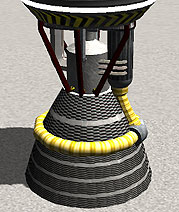Reaction engine
A rocket engine is an engine that uses nothing but its onboard propellant to generate thrust. Unlike traditional air breathing engines used by atmospheric crafts rocket engines are able to function in a vacuum where no oxygen is present.
Contents
History
Rocket engines were present in KSP in all public releases of the game.
Approaches to Rocket Engines
Rocket engines come in two commonly used forms. The first and most ancient type is a solid fuel rocket which is as simple as igniting a solid, self-oxidizing compound within the casing of the rocket and allowing the escaping gases to be released through a nozzle at the rear.
Liquid fuel engines are powered by a liquid propellant which is usually comprised of two separate fuels which are combined and ignited, typically liquid hydrogen and liquid oxygen or liquid kerosene, and liquid oxygen. In KSP there are two different types of liquid rocket engines; aerospike and bell type liquid rocket engines.
Advantages of Solid Fuel Rocket Engines
- Has a very high thrust to weight ratio
- Simple design with no moving parts.
- Less prone to failure than most other rocket engine types
Disadvantages of Solid Fuel Rocket Engines
- Cannot be throttled
- Once spent, they are unable to use fuel from another source of the craft
Advantages of Liquid Fuel Rocket Engines
- Can use fuel stored elsewhere on the craft
- Throttle can be adjusted depending on thrust requirements
- Many nozzles can be gimballed for thrust vectoring
Disadvantes of Liquid Fuel Rocket Engines
- Lower power to weight ratio than liquid rocket engines
- Vary greatly in thrust efficiency from one motor to the next
